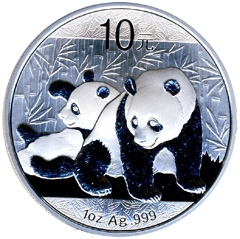 The use of silver as a monetary asset in China goes back for centuries. As detailed in the latest report from the Silver Institute, China’s entire monetary system was based on a silver standard until 1935. Things changed dramatically after the Communists came to power in 1949 and effectively nationalized the entire silver stock. Private citizens were prohibited from owning silver or gold and private sales of silver and gold jewelry was banned.
The use of silver as a monetary asset in China goes back for centuries. As detailed in the latest report from the Silver Institute, China’s entire monetary system was based on a silver standard until 1935. Things changed dramatically after the Communists came to power in 1949 and effectively nationalized the entire silver stock. Private citizens were prohibited from owning silver or gold and private sales of silver and gold jewelry was banned.
As China slowly adopted free markets principles, government control over silver was liberalized and in 2000, China finally ended the government monopoly on silver trading. Private exchanges were established which allowed both the supply and demand of silver to expand rapidly.
A momentous moment for silver occurred in 2009 when the People’s Bank of China finally allowed private investors to buy silver. The opening of the silver market to the Chinese public along with explosive economic growth resulted in an exponential increase of silver demand. A middle and upper class that was rapidly accumulating financial assets saw silver as the logical store of value to protect their wealth from inflation and currency debasement.
Removing the prohibition on the private ownership of silver resulted in explosive demand for silver bar, coins and metals. Demand for coins and medals increased from 3.0 million ounces in 2009 to 5.8 million ounces in 2011. Demand for silver bar increased from 1.3 million ounces in 2009 to 11.3 million ounces in 2011.
The Silver Institute projects that retail investment demand for silver will grow robustly as silver becomes more available to the growing masses of the Chinese middle class. Currently, investor demand for silver accounts for only a small part of total silver demand. In 2011, total Chinese silver demand was 170.7 million ounces, with investors purchasing only 17.1 million ounces of coins, medals and bars. With a population of almost 1.4 billion people, demand for silver could surge exponentially. If only 1 out of 4 people in China buy one ounce of silver each year, that would represent silver demand of a staggering 350 million ounces, which exceeds total annual silver supply of 281.5 million ounces in 2011.
Long term investors in both gold and silver who understand the underlying fundamental reasons for owning precious metals should ignore short term price fluctuations and increase positions on short term weakness.
 China and its people have a long held interest in the gold market. The country’s history has been marked by periods of unrest, and its people have regularly chosen to heed history’s warnings when it comes to investment. Their general preference has been for investments that they perceive as safe and solid, as opposed to paper instruments. Thus, their top two investment choices are gold and real estate.
China and its people have a long held interest in the gold market. The country’s history has been marked by periods of unrest, and its people have regularly chosen to heed history’s warnings when it comes to investment. Their general preference has been for investments that they perceive as safe and solid, as opposed to paper instruments. Thus, their top two investment choices are gold and real estate.